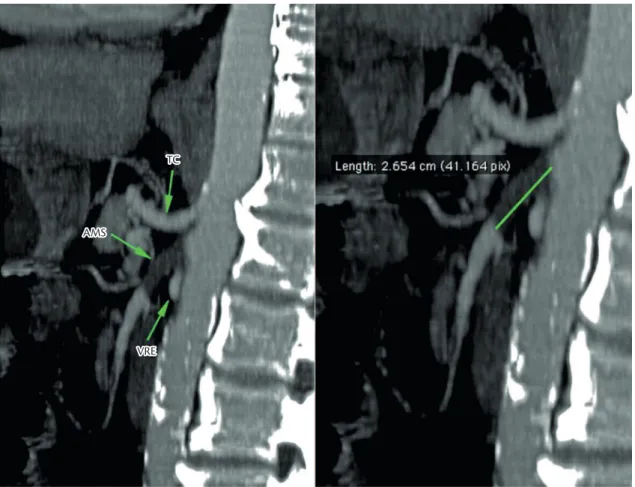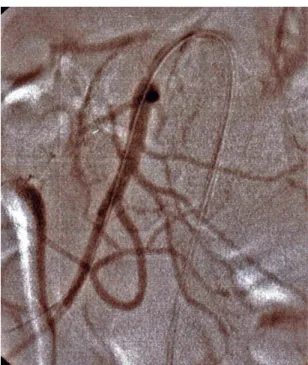151
J Vasc Bras. 2013 Jun; 12(2):151-154
T H E R A P E U T I C
C H A L L E N G E
Endovascular treatment of iatrogenic
acute mesenteric ischemia
Tratamento endovascular da isquemia mesentérica aguda iatrogênica
Ricardo de Alvarenga Yoshida1, Paulo Roberto Bahur Vieira2, Winston Bonetti Yoshida3,
Marcone Lima Sobreira4, Rodrigo Gibin Jaldin5
INTRODUCTION
Acute mesenteric ischemia is not a common condition, occurring at a rate of one case in every 1000 hospital admissions in the United States1. The
majority of these cases are the result of emboli or thrombotic occlusions. This is a dangerous condition, with mortality around 60% and may require extensive
bowel resection2. The primary risk factors for
embolisms are atrial ibrillation, recent myocardial
infarction and heart failure. Important warning signs of thrombotic occlusions include postprandial abdominal pains and food intolerance. Superior mesenteric artery (SMA) showing acute occlusion related to iatrogenic causes have received little attention in the literature and those that have been described are generally related to prior endovascular procedures3-5. In this article we describe a case of
acute occlusion of the superior mesenteric artery after conventional surgery to treat intestinal cancer by total colectomy. The occlusion was successfully resolved by endovascular surgery.
PART I – THE CASE
A 62-year old male patient with colorectal cancer underwent total colectomy surgery to treat synchronic adenocarcinoma of the ascending colon and rectum. The surgical records state that venous bleeding occurred during the operation at the level of the SMA and was staunched using several hemostatic sutures. Forty-eight hours later the patient exhibited vomiting, abdominal distension and diffuse abdominal pains, suggesting an acute abdomen case. He underwent angiotomography, which showed a proximal occlusion of the SMA (2.6 cm long, see Figure 1).
There were some treatment options in this case:
• Explorative laparotomy;
• Endovascular treatment with revascularization of the SMA with stent placement;
• Open surgery with revascularization of the SMA with an embolectomy catheter and/or bypass.
PART II – THE TREATMENT
Considering that the patient was in postoperative recovery from major surgery, the decision to perform endovascular treatment was taken, as it was less invasive option, attempting to reverse the vascular acute abdomen caused by the initial phases of mesenteric ischemia. During the total colectomy, the inferior mesenteric artery (IMA) had been intentionally ligated compromising the Riolan Arch and there was also possible inadvertent involvement of SMA by hemostatic sutures along the superior mesenteric vein that could contribute to deficit of intestinal blood supply. Therefore, the aim of endovascular treatment would be to rescue the SMA, saving the small intestine from ischemia, which could cause intestinal necrosis, requiring bowel resection that could lead to Short Bowel Syndrome and / or septic complications.
A right femoral approach was used to perform an aortography, which only showed the celiac trunk, the renal arteries and the ostium of the SMA (arterial stump). The aorta was patent with normal
blood low, no lumen wall irregularities or parietal calciications, not suggesting atherosclerosis. The
SMA was selectively catheterized from its origin using an angiographic catheter, but a stiff hydrophilic guidewire could not cross the occlusion. The 11 cm sheath was therefore changed for a 45 cm one with
1Angiovalle, São José dos Campos, SP, Brasil.
2Universidade Estadual Paulista – UNESP, Faculdade de Medicina de Botucatu, Departamento de Cirurgia e Ortopedia, Botucatu, SP, Brasil. 3Universidade Estadual Paulista – UNESP, Faculdade de Medicina de Botucatu, Botucatu, SP, Brasil.
Financial support: None.
Conlicts of interest: No conlicts of interest declared concerning the publication of this article. Submitted: 06.23.12. Accepted: 01.06.13.
Acute mesenteric ischemia iatrogenic
152 J Vasc Bras. 2013 Jun; 12(2):151-154
of residual stenosis and normal blood low to the
SMA (Figure 3).
The patient evaluated well, with complete remission of the symptoms of nausea and abdominal pain soon after the procedure. Abdominal distension receded over 24 hours and after 48 hours the patient was taken off the nasogastric tube and was discharged 72 hours after surgery.
Three weeks after the operation, a follow-up mesenteric angiotomography showed a patent stent
with normal blood low through the lumen and no
sign of residual stenosis (Figure 4).
DISCUSSION
Reports on iatrogenic occlusion of the SMA during conventional gastrointestinal surgical procedures
are rare. We were only able to ind a single report
describing iatrogenic dissection of this artery, which was treated using an endovascular procedure3. There
are no prior descriptions of a similar case to this, in which the SMA was occluded by a iatrogenic injury and treated by endovascular approach.
an RDC curvature, in order to improve the support for endovascular devices. The SMA was once more selectively catheterized from its origin using an angiographic catheter, now supported by the longer sheath, and this time it was possible to cross the occlusive lesion with the stiff hydrophilic guidewire.
Angiography showed that blood low was normal
beyond the initial occluded segment of the artery and there were no lumen wall irregularities or parietal
calciications, corroborating the hypothesis of a local
iatrogenic injury (Figure 2). The stiff hydrophilic guidewire was then changed for a 0.014 mm extra support guidewire. Therefore an attempt was made to place a 6.0 mm × 49 mm balloon-expandable stent across the occlusion at the origin of the SMA, without
success. Thus it was necessary to use the “Buddy
Wire” technique, using a stiff hydrophilic guide wire to help advancing the balloon-expandable stent
delivery device, which was supported by the 0.014 guide wire. After the stent had been correctly placed, the stiff hydrophilic guidewire was then removed and the stent successfully expanded. Control angiography showed that the stent was well-placed, with no sign
Ricardo de Alvarenga Yoshida, Paulo Roberto Bahur Vieira et al.
153
J Vasc Bras. 2013 Jun; 12(2):151-154 Suspected SMA occlusion can be confirmed
by ultrasound, angiocomputerized tomography or angiography. The treatment options for acute cases are: laparotomy with embolectomy; saphenous vein or synthetic grafts bypasses; hybrid de-obstruction procedures4,6,7; or endovascular angioplasty with stent
placement (primarily for thrombotic occlusions)1. It
is also possible to perform thrombolysis followed
by angioplasty with stent8,9, which is primarily
used in cases when the obstruction has reached more distal portions of the artery10-13. However,
although preliminary thrombolysis prevents distal mesenteric embolisms, it can also cause hemorrhagic complications and was therefore contraindicated in this case by the recent major surgery.
In the case described here, there was a short occluded segment, without injury to distal portions, possibly provoked by the iatrogenic stenosis, and, since there were only recently-formed, small, unorganized thrombosis, catheterization itself was
performed without major dificulties. However, the
task of advancing the balloon-expanded stent through the occluded injured segment presented technical
dificulty. The “Buddy Wire” technique facilitated
progression of balloon-expandable shaft and its
placement, making it possible to release the stent
successfully and restore blood low to the artery,
avoiding severe mesenteric ischemia complications. Observation of a larger number of cases will be necessary before this technique could be proposed as the most viable option or the method of choice in these cases. Notwithstanding, in this case the technique avoided the need for re-laparotomy or
Figure 2. Intraoperative diagnostic angiography – critical
ste-nosis detected on passing the occlusion at the initial injured section of the SMA.
Figure 3. Control angiography – showing the stent
well-located, no signs of residual stenosis and normal blood low through the SMA.
Figure 4. Follow-up control angiotomography 3 weeks
Acute mesenteric ischemia iatrogenic
154 J Vasc Bras. 2013 Jun; 12(2):151-154
9. Resch TA, Acosta S, Sonesson B. Endovascular techniques in a cute ar terial m e s enteri c is ch em ia . S em in Va s c Surg. 2010;23:29-35. PMid:20298947. http://dx.doi.org/10.1053/j. semvascsurg.2009.12.004
10. Gartenschlaeger S, Bender S, Maeurer J, Schroeder RJ. Successful percutaneous transluminal angioplasty and stenting in acute mesenteric ischemia. Cardiovasc Intervent Radiol. 2008;31:398-400. PMid:17205365. http://dx.doi.org/10.1007/s00270-006-0147-z 11. Hawkins BM, Khan Z, Abu-Fadel MS, Exaire JE, Saucedo JF,
Hennebry TA. Endovascular treatment of mesenteric ischemia. Catheter Cardiovasc Interv. 2011;78:948-52. PMid:21523886. http://dx.doi.org/10.1002/ccd.23098
12. Gagniere J, Favrolt G, Alidja A, et al. Acute thrombotic mesenteric ischemia: primary endovascular treatment in eight patients. Cardiovasc Intervent Radiol. 2011;34:942-8. PMid:21717248. http://dx.doi.org/10.1007/s00270-011-0212-0
13. Demirpolat G, Oran I, Tamsel S, Parildar M, Memis A. Acute mesenteric ischemia: endovascular therapy. Abdom Imaging. 2007;32:299-303. PMid:16967242. http://dx.doi. org/10.1007/s00261-006-9074-3
Correspondence
Ricardo de Alvarenga Yoshida FMB-UNESP Av. Bento Lopes, 679 – Rubião Junior CEP 18618-970 – Botucatu (SP), Brazil Fone: (14) 3811-6269 E-mail: ricardoyoshida@gmail.com
Author contributions
RAY is a vascular and endovascular surgeon at Angiovalle; Collaborating professor in the discipline of Vascular and Endovascular Surgery at Faculdade de Medicina de Botucatu (FMB), Universidade Estadual Paulista (UNESP); PhD, Department of Surgery and Orthopedics, FMB (UNESP). PRBV is a vascular and endovascular surgeon at Angiovalle. WBY is full professor and chief of the Service of Vascular and Endovascular Surgery at FMB (UNESP). MLS is assistant professor of the Service of Vascular and Endovascular Surgery at FMB (UNESP). RGJ is assistant physician of the Service of Vascular and Endovascular Surgery at FMB (UNESP), Department of Surgery and Orthopedics, FMB (UNESP).
Author information
Conception and design: RAY, WBY Analysis and interpretation: RAY, WBY Data collection: RAY, WBY, PRBV, MLS, RGJ Writing the article: RAY, WBY Critical revision of the article: RAY, WBY Final approval of the article*: RAY, WBY, PRBV, MLS, RGJ Statistical analysis: N/A Overall responsibility: RAY
*All authors have read and approved the inal version submitted to J Vasc Bras. for even more invasive techniques to repair vessels,
in a patient who had already been debilitated by his underlying disease and the extensive nature of the prior surgery he had undergone. This treatment also avoided the need for more radical intestinal resection, sparing the patient from the symptoms associated with a Short Intestinal Syndrome and from the complications associated with necrosis or a perforated bowel, while also guaranteeing a more easily tolerated postoperative recovery process.
REFERENCES
1. Wyers MC. Mesenteric Vascular Disease: Acute Ischemia. In: Cronenwett JL, Johnston KW, editors. Rutherford’s Vascular Surgery. Philadelphia: Saunders, 2010. v. 2, p. 2289-2303. http:// dx.doi.org/10.1016/B978-1-4160-5223-4.00149-9
2. Sánchez Fernández P, Mier y Díaz J, Blanco Benavides R. Isquemia mesentérica aguda: semblanza de una enfermedad agresiva; Acute mesenteric ischemia: the face of an aggressive disease. Rev Gastroenterol Méx. 2000;65:134-140. PMid:11464607.
3. Murphy TP, Dorfman GS, Segall M, Carney Junior WI. Iatrogenic arterial dissection: treatment by percutaneous transluminal angioplasty. Cardiovasc Intervent Radiol. 1991;14:302-6. PMid:1834338. http://dx.doi.org/10.1007/BF02578455
4. Sonesson B, Hinchlife RJ, Dias NV, Resch TA, Malina M, Ivancev K. Hybrid recanalization of superior mesenteric artery occlusion in acute mesenteric ischemia. J Endovasc her. 2008;15:129-32. PMid:18254664. http://dx.doi.org/10.1583/07-2210.1
5. Oderich GS, Tallarita T, Gloviczki P, et al. Mesenteric artery complications during angioplasty and stent placement for atherosclerotic chronic mesenteric ischemia. J Vasc Surg . 2012;55:1063-71. PMid:22322121. http://dx .doi. org/10.1016/j.jvs.2011.10.122
6. Stout CL, Messerschmidt CA, Leake AE, Veale WN, Stokes GK, Panneton JM. Retrograde open mesenteric stenting for acute mesenteric ischemia is a viable alternative for emergent revascularization. Vasc Endovascular Surg. 2010;44:368-71. PMid:20484073. http://dx.doi.org/10.1177/1538574410369568
7. Wyers MC, Powell RJ, Nolan BW, Cronenwett JL. Retrograde mesenteric stenting during laparotomy for acute occlusive mesenteric ischemia. J Vasc Surg. 2007;45:269-75. PMid:17264001. http://dx.doi.org/10.1016/j.jvs.2006.10.047

